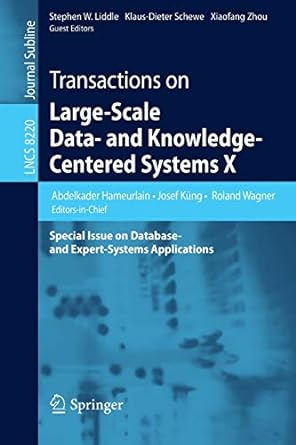Question
Question 1 (1 point) Which of the following can be used for the incremental learning task? Question 1 options: perceptron instance-based learning COBWEB clustering all
Question 1 (1 point)
Which of the following can be used for the incremental learning task?
Question 1 options:
| perceptron | |
| instance-based learning | |
| COBWEB clustering | |
| all of the above | |
| none of the above |
Question 2 (1 point)
Using the terminology of our textbook, the input to data mining involves concepts, instances and attributes. Which of the following is not a good pairing of synonyms (i.e., words with same or similar meanings in a certain context)?
Question 2 options:
| concept, class | |
| attribute, value | |
| instance, example | |
| these are all good pairings | |
| these are all not good pairings |
Question 3 (1 point)
Which of the following is considered as a supervised learning algorithm?
Question 3 options:
| logistic regression model | |
| instance-based learning (nearest neighbor) | |
| k-means clustering | |
| a, b, c | |
| a, b |
Question 4 (1 point)
Which of the following is not a form of a learned model or representation of knowledge obtained through machine learning?
Question 4 options:
| clusters | |
| association rules | |
| a linear regression formula | |
| instance-based representation | |
| these are all forms of learned models |
Question 5 (1 point)
In the 1R algorithm, there is a count of errors for rules based on a single attribute. The number of errors for the rules based on Aquatic in Table 1 is:
Table 1: Vertebrate Dataset (modified from Introduction to Data Mining by Tan et al.)
| Name | Body temp | Give birth | Aquatic | Class |
| human | warm | yes | no | mammal |
| echidna | warm | no | no | mammal |
| salmon | cold | no | yes | fish |
| whale | warm | yes | yes | mammal |
| eel | cold | no | yes | fish |
| bat | warm | yes | no | mammal |
| shark | cold | yes | yes | fish |
| cat | warm | yes | no | mammal |
Question 5 options:
| 0 | |
| 1 | |
| 2 | |
| 3 | |
| none of the above |
Question 6 (1 point)
Consider a numeric attribute Z, where its values are as follows with the class associated below:
130, 100, 70, 120, 60, 150, 75, 75, 90, 95
yes, yes, no, yes, no, yes, no, yes, no, no
Discretize this attribute, assuming that a division requires at least three of the majority class, and that you form the divisions starting at the lowest number, and increasing in the sorted values. The first of these divisions is between
Question 6 options:
| 75, 90 | |
| 70, 75 | |
| 90, 95 | |
| 75, 75 | |
| 95, 100 |
Step by Step Solution
There are 3 Steps involved in it
Step: 1

Get Instant Access to Expert-Tailored Solutions
See step-by-step solutions with expert insights and AI powered tools for academic success
Step: 2

Step: 3

Ace Your Homework with AI
Get the answers you need in no time with our AI-driven, step-by-step assistance
Get Started


